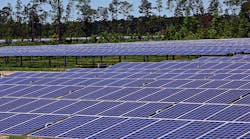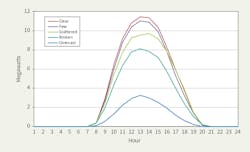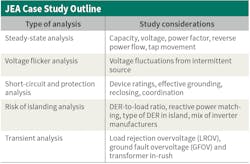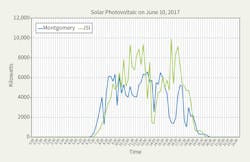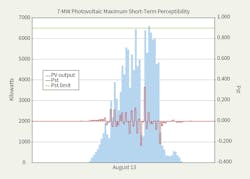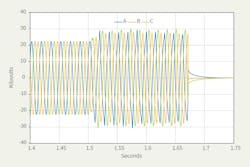Maintaining the power quality and reliability of the grid becomes more challenging as customers and utilities add solar generation sources. Conducting comprehensive impact studies and implementing various screening methods are two approaches JEA uses to provide reliable electric service while continuing to explore more opportunities to increase its solar portfolio.
Like many utilities, JEA recognizes the need to address technical issues, such as voltage rise, voltage flicker and the risk of islanding, and to adopt sustainable policies and procedures surrounding distributed energy resources (DERs). By observing and learning from the pioneering work of other utilities with large amounts of solar, such as those in California, Hawaii, Arizona and the Northeastern region of the U.S., JEA continues to evaluate policies, procedures and customer programs that will promote solar in sustainable ways for the utility, its customers and the environment.
Solar Penetration
With a service territory of approximately 900 sq miles (2330 sq km) in northern Florida and a base of about 460,000 electric retail customers, JEA is the eighth largest community-owned municipal utility in the U.S. By 2014, the utility had become home to the 12-MW Jacksonville solar project, multiple individual photovoltaic (PV) installations on municipal facilities, such as schools, city buildings and the Jacksonville Zoo, and approximately 1000 residential net-metering customers.
Through a board-approved solar policy in late 2014, JEA planned a fourfold increase in its solar portfolio from 12 MW to 50 MW. After installation of the planned solar PV projects to meet the 50-MW target, solar PV will account for approximately 1% of JEA’s total energy.
JEA faces several challenges due to the increasing penetration of solar generation. In addition to the potential impacts to the distribution system — such as thermal overload, protection and coordination, stability and overvoltages — the intermittent nature of solar generation also can present operational challenges. In Jacksonville, there is approximately a 40% loss in energy output due to cloud coverage in the region over a 12-month period.
For the solar projects in which JEA entered into power purchase agreements, a primary goal was to scatter the solar facilities in locations across the service territory to minimize the weather impacts from those facilities. Another goal was to limit the size of solar PV systems based on minimum daytime load of the interconnecting circuit and the adjacent circuit to restrict reverse power flow through the substation transformers.
To identify and understand the key concerns related to the addition of a utility-scale solar PV facility to the JEA electric system, the utility reached out for consulting support in performing an interconnection study.
A Case Study
JEA collaborated with Leidos to conduct a case study based on a 7-MW solar project interconnecting to a 26.4-kV distribution circuit. The study focused on whether the project would create power quality and reliability issues on the distribution circuit for JEA and its customers. The study results would enable the utility to determine whether any system upgrades would be required for the interconnection of the solar project. The study results also were useful in revising JEA’s standard study practices for DERs as well as revising its interconnection requirements.
The study incorporated industry standards such as IEEE 1547, the standard for interconnecting distributed resources with electric power systems; existing JEA standards for interconnections and distributed generation; and industry best practices for study methods and various technical assumptions. The study included a thorough set of analyses to determine potential issues and technical interconnection requirement violations. At daytime peak and light load scenarios, the analyses included steady-state analysis, voltage flicker analysis, short-circuit and protection analysis, risk of islanding analysis and transient analysis.
The circuit in the study had a small 168-kW amount of residential net-metering customers on-line, which were considered for the analyses as existing and on-line. Prior to performing the analyses, data and engineering model validation was conducted to ensure the accuracy of various models for valid study results. Time was spent confirming the status of JEA’s existing DNV GL Synergi distribution model and a newly built transient analysis model in PSCAD.
Along with study model validation, careful attention was given to testing the inverter manufacturer’s model provided for transient analysis. Documentation from the inverter manufacturer was provided to illustrate inverter response to system disturbances, including ride-through and inverter protection details.
Simulations were performed to confirm the inverter manufacturer’s results matched the results with the inverter model added to the JEA distribution model. The study results indicated the IEEE 1547 settings for the inverter generated an overvoltage response outside the standard curve of the Computer and Business Equipment Manufacturers Association (CBEMA) and Information Technology Industry Council (ITIC).
JEA and Leidos collaborated with the inverter manufacturer on a solution to clear the overvoltage response on the distribution system during distribution disturbances, such as load rejection and ground fault scenarios, faster than the IEEE 1547 response for the 7-MW solar project. Multiple simulations were performed to deduce a target clearing time to mitigate the transient overvoltage.
Another interesting result that may not be obvious when thinking about DER-to-load penetration issues is, while the risk of islanding might be negligible based on various screening methods in the industry, higher levels of solar PV penetration can lead to unacceptable and damaging overvoltages, even in a transient time domain. This situation can occur with a circuit breaker response or even a midstream protective device response, with heavy penetration of DER downstream.
Study Results
Results indicate a large utility-scale project as far as 6.5 miles (10.5 km) away from the substation can interconnect without causing major system upgrades. However, from the study, the utility identified some seemingly minor requirements that could lead to larger system issues if ignored. They primarily have to do with protection and inverter response. From the analyses, the utility learned the following:
• The steady-state analysis identified the voltage and capacity of the distribution circuit would not be impacted adversely from the addition of the 7-MW solar project, apart from a planned capacity upgrade on the circuit tap interconnecting the project. Based on a year of substation transformer data and estimations of the project output over the same time period, reverse power flow is not expected through the substation transformer, even considering potential N-1 scenarios that could reduce the bus load. Excessive tap movement at the substation transformer load-tap changer (LTC) is not expected with the new solar PV source on the circuit, and the power factor requirements at the substation level can still be maintained.
• The voltage flicker analysis identified a single timestamp voltage flicker of 3.81% is not expected to occur frequently but is potentially high enough to be noticeable even as a rare occurrence. However, the conductor upgrade project for the circuit alleviated this concern.
• The short-circuit and protection analysis identified the JEA distribution circuit remains effectively grounded with the project on-line. Two protective devices upstream of the project are between the project point of interconnection and the distribution circuit breaker. The protection analysis concluded a fuse should be relocated because of capacity concerns. In addition, concerns for miscoordination on the upstream recloser with the utility-owned PV site recloser led to a recommendation to replace the midstream recloser with an electronic device for more options with curve speeds and response times.
Protective device reclosing on the circuit protective devices should be set to not reclose for at least 2 seconds, leaving time for the PV to be fully off-line, as documented in IEEE 1547. This setting is becoming an industry approach to protection-related issues with DER on distribution circuits.
• The risk of islanding screening identified the DER-to-light load percentage could reach 294% at the circuit breaker and 740% at the midstream recloser. However, other concerns that generally trigger islanding, such as other types of generation on the circuit and reactive power matching, were not concerns on this circuit.
• The transient analysis was performed in PSCAD and included load rejection, ground fault and in-rush simulations. Results from the study identified there could be overvoltage violations outside the CBEMA/ITIC standard curve during load rejection events, where the circuit breaker or midstream recloser opens while the PV site is on-line.
The event results in voltage over 1.2 per unit for 0.0297 seconds, which is a violation of the CBEMA/ITIC standard. Similar findings occurred during the midstream recloser event. The inverter manufacturer conducted inverter model updates to include the real-world protection mechanisms in addition to the existing modeled IEEE 1547 trip settings. The self-protection overvoltage (SPOV) relay within the inverter actually is set to trip at 1.2 per unit voltage in 3.33 msec and 1.25 per unit voltage in 1.83 msec. In conducting updated simulations for load rejection, there were still violations outside the CBEMA/ITIC standard.
Because of this finding and following extensive research on updated practices, the upcoming release of the revised IEEE 1547 standard provides an update for overvoltage simulations. While still in draft mode, the upcoming allowable voltage ranges provide slightly different windows of time for allowable overvoltages. Using the revised criteria, the results were acceptable, considering the inclusion of the SPOV relay.
In addition to the technical requirements for PV site interconnection that came from the study, JEA had to consider other outcomes. JEA reflected on this study to consider how study methods could be adapted to gain efficiency and accuracy in performing future impact studies. One study method JEA is discussing currently relates to the risk of islanding screening.
While various methods are used in the industry, this study found that heavy penetration alone did not necessarily trigger islanding concerns, based on industry standards. However, this heavy penetration can result in overvoltage concerns, which generally are not considered in the islanding screenings in the industry. Going forward, this is a trigger for JEA to adopt into its screening criteria as well as the new criteria coming in the expected revision of IEEE 1547.
PV Future
Overall, the study demonstrated that by giving attention to some small differences in inverter settings, the utility could avoid potential power quality problems later. The study results also confirmed the importance of utility engagement in areas such as interconnection standards. These standards may impact future interconnection requirements as well as the testing and certification procedures for inverter-based generation. While this study focused on a utility-scale solar project, the results also will apply to smaller systems, such as net-metering customers, as a high number of customers on a single circuit would create similar impacts.
JEA continues to participate with various leaders in the industry, including consultants and DER-focused agencies, to investigate the impacts and opportunities of interconnecting large amounts of solar generation on the electric power system in an effort to build a sustainable future for the utility and its customers. ♦
Matt Lundeen is system analysis manager at JEA. He holds a BSEE degree from the University of Florida and is currently pursuing an MSEE degree specializing in power and energy from the New Jersey Institute of Technology. In his current role, Lundeen leads a team implementing projects that improve the reliability and power quality of the electric distribution system at JEA.
Trishia Swayne is director of system planning and protection at Leidos. She has a bachelor’s degree in engineering physics, holds an MBA degree from Murray State University and is a registered professional engineer. Swayne leads a team that performs distributed energy interconnection impact studies and distribution planning services for utilities.
Check out the September 2017 issue for more articles, news and commentary.
